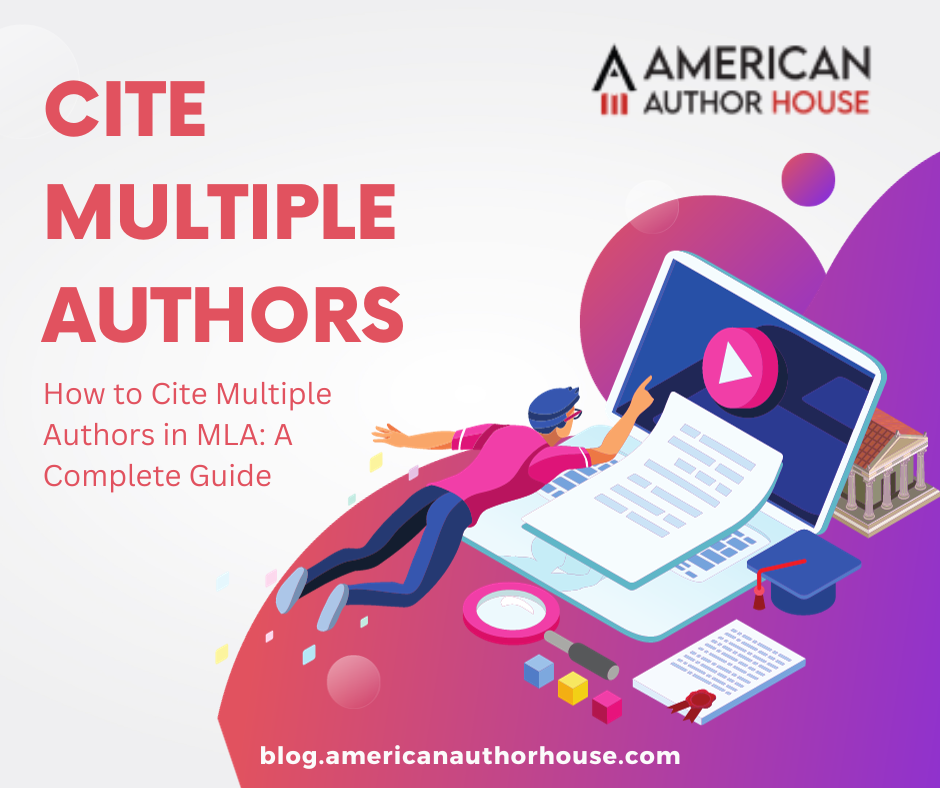
Writers
Proper citation serves as the backbone of credible and authoritative content. When writing academic papers or conducting research, it is essential to properly cite multiple authors to give credit to the original authors and avoid plagiarism.
Modern Language Association (MLA) style is widely used for research papers in humanities. It provides guidelines for formatting manuscripts and citing research in writing. If you’re interested in understanding more about MLA, you might want to explore the difference between Amazon Choice vs Best Seller.
The basic MLA format includes the author’s last name and the page number within parentheses, placed at the end of the quoted or paraphrased sentence.
A Quick Guide for Your Understanding
You should have the proper knowledge to cite multiple authors in MLA (Modern Language Association) style. Also, it will depend on the number of authors and the specific citation format you are using.
Here is a complete guide on how to cite multiple authors in MLA:
Citing Two Authors in MLA Format
When dealing with a work written by two authors, citing both names in your in-text citation is essential.
Here is how you do it:
According to Smith and Johnson (45), …
In the Works Cited page, the citation will look like this:
Smith, John, and Emily Johnson. Title
of the Book. Publisher, Year.
Citing Three or More Authors in MLA Format
Citing works with three or more authors might seem tricky, but fear not, for MLA also provides a clear guideline for this scenario.
In your in-text citation, use the first author’s name followed by “et al.,” which is Latin for “and others”:
(Last Name of the First Author Et al. Page Number)
In the Works Cited page, list the first author’s name followed by “et al.”:
Smith, John, et al. Title of the Book. Publisher, Year.
Citing Multiple Works by the Same Author
Now, let’s address a common dilemma: how to cite multiple authors by the same author. In this case, distinguish between the works by adding a shortened version of the title in your in-text citation:
(Author’s Last Name, Shortened Version of the Title, Page Number)
In the Works Cited page, the citation will include the full title of the work:
Smith, John. Full Title of the Book. Publisher, Year.
Citing Corporate Authors
When the source has a corporate author, incorporate the organization’s name in the citation. For example:
(American Medical Association 112). This approach ensures proper attribution, even when individual authorship is ambiguous.
Including In-Text Citations
In-text citations are essential in scholarly writing as they provide readers with immediate information about the source of the information. Properly placed in-text citations enhance the credibility of your work and demonstrate meticulous research.
If you cite multiple sources in one sentence, separate the citations with a semicolon. For example: (Smith and Johnson, 32; Brown et al., year, 78; “Title of Source” 56).
Creating a Works Cited Page
In addition to in-text citations, compiling a comprehensive Works Cited page is crucial. Arrange the sources alphabetically based on the authors’ last names.
Include all the necessary publication details, such as the work’s title, the author’s name, the publication date, and the source medium (print, web, etc.). The Works Cited page provides readers with a roadmap to explore your referenced sources.
On the Works Cited page, provide a full citation for each source. Include all authors’ names in the order they appear on the source. For example:
- For a source with two authors: Last Name, First Name, and First Name Last Name. Title of Source. Publisher, Year.
- For a source with three or more authors: Last Name, First Name, et al. Title of Source. Publisher, Year.
- For a source with no authors: “Title of Source.” Publisher, Year
Using Online Sources with Multiple Authors
In our digital age, online sources have become ubiquitous. Citing them correctly is paramount.
For online sources with multiple authors, follow the same principles as you would for print sources. Explore more about how to publish a book on Amazon and make money, ensuring that you provide the authors’ names and the page number (if available) in your in-text citation.
Importance of Proper Citation
A clear understanding of how to cite multiple authors is integral to academic integrity and responsible research. Discover more about the importance of proper citation at how long does it take to read 100 pages?. It promotes ethical writing, establishes credibility, and allows for the advancement of knowledge by providing a transparent framework for exchanging ideas and information.
The importance of proper citation in academic writing and research cannot be overstated. Proper citation serves several crucial purposes:
Giving Credit to The Original Authors
By citing your sources correctly, you acknowledge and credit the authors or creators of the works you have used. This demonstrates respect for intellectual property and recognizes the efforts and contributions of others.
Avoiding Plagiarism
Plagiarism, the act of using someone else’s work without acknowledgment, is a serious academic offense. It is a serious ethical breach in academic writing.
Citations safeguard the integrity of your work by clearly delineating what ideas are yours and what is sourced from others. Proper citation acts as a shield, ensuring you are not inadvertently stepping into the realm of plagiarism.
It ensures that you clearly distinguish your ideas from those of others, thus avoiding plagiarism.
Establishing Credibility
You enhance your credibility as a researcher or writer when you cite reputable and reliable sources. Readers can evaluate the credibility and quality of your work based on the sources you have used and the way you have cited them.
Allowing Verification and Further Research
Proper citation enables others to locate and verify the sources you have used. It facilitates the replication of experiments, further exploration of research topics, and the development of new ideas based on existing scholarship.
Building Upon Existing Knowledge
Citing relevant and related sources allows you to situate your work within the larger scholarly conversation. By acknowledging the existing body of knowledge, you can demonstrate how your work contributes to and builds upon the work of others.
Ensuring Clarity and Transparency
It provides a clear way for readers to follow your line of research, understand your sources, and delve deeper into specific aspects of your work if desired. This transparency allows for more meaningful engagement and evaluation of your ideas.
Supporting Your Argument
Citations are not just a form of academic etiquette; they bolster your arguments. When you cite authoritative sources, you provide a solid foundation for your claims.
Your assertions gain credibility and weight, making your work more persuasive. Well-cited research stands tall, fortified by the pillars of established knowledge.
Promoting Future Research
It is a contribution to the scholarly community. By citing sources accurately, you enable future researchers to explore the same intellectual terrain.
Your citations become entry points for others, guiding them to relevant literature, theories, and methodologies. Your meticulous citations pave the way for the continuous growth of knowledge.
Navigating the Sea of Information
Proper citation acts as a quality filter, helping readers discern between credible, peer-reviewed sources, and unreliable information. You guide readers through the overwhelming sea of information by citing reputable sources, ensuring they rely on accurate and trustworthy material.
Acknowledging Intellectual Debts
Every academic work is built upon the foundations laid by countless scholars before. Proper citation is a mark of respect, acknowledging the intellectual debts you owe to those who paved the way.
It’s a nod to the giants on whose shoulders you stand, recognizing their contributions to your scholarly endeavors.
Facilitating Knowledge Traceability
Imagine reading a compelling argument in a research paper without knowing where the information comes from. Citations provide a roadmap for readers, enabling them to trace the origins of ideas, theories, and evidence.
This traceability fosters transparency, allowing readers to validate the claims made and engage with the material critically.
The Complexity of Citing Multiple Authors in MLA
Below are some complexities discussed by American Author House while citing:

Distinguishing Similar Authors
Imagine you’re citing two sources, both authored by individuals with identical last names. Navigating this scenario requires meticulous attention to detail. In such cases, the inclusion of first initials becomes crucial.
These seemingly small details prevent confusion and ensure the accuracy of the citation.
Secondary Sources and Nested Citations
In scholarly discourse, it is common to encounter secondary sources where one author references another author’s work. Nested citations, though intellectually enriching, complicate the citation process.
Deciding how to credit the primary and secondary sources demands careful consideration. Should you cite the original work directly or rely on the secondary source? Understanding the context is key to making an informed decision.
Multiple Authors, Multiple Formats
One of the primary complexities of how to cite multiple authors lies in the
diversity of sources. Whether it’s a book, a journal article, a website, or an anthology, each format demands a different approach.
In the case of books, for instance, citing two authors requires a different format than citing multiple authors in a web source. Understanding the intricacies of each format is essential for accurate citation.
Translated Works
In our globally connected world, citing translated works is common. However, ensuring the proper acknowledgment of both the original author and the translator adds complexity. Translators play a vital role in bridging language barriers, and their contributions deserve recognition.
Accurate citation necessitates meticulous acknowledgment of both the source’s author and the translator, ensuring scholarly integrity.
Essential Topics and Detailed Insights
| Topic | Details | Examples |
|---|---|---|
| Citing Two Authors | In-text citation of a work by two authors includes both names. | Smith and Johnson (45) |
| Citing Three or More Authors | Use the first author’s name followed by “et al.” for in-text citation. | (First Author’s Last Name et al. Page Number) |
| Multiple Works by the Same Author | Distinguish works by the same author with a shortened title in the citation. | (Author’s Last Name, Shortened Title, Page Number) |
| Citing Corporate Authors | Include the name of the organization for corporate authors. | (American Medical Association 112) |
| In-Text Citations | Essential for providing immediate source information. Separate multiple sources with a semicolon. | (Smith and Johnson, 32; Brown et al., year, 78; “Title of Source” 56) |
| Works Cited Page | List full citations alphabetically by author’s last name. Include all publication details. | Smith, John, and Emily Johnson. Title of the Book. Publisher, Year. |
| Online Sources | Follow the same principles as print sources. Include authors’ names and page number if available. | (Author’s Last Name, Page Number) |
Conclusion
To cite multiple authors in MLA can be complex due to the various rules depending on the number of authors and the location of the citation. It is crucial to remain consistent in your citation style and cite sources properly by crediting the original authors, avoiding plagiarism, and allowing readers to find and verify information.



